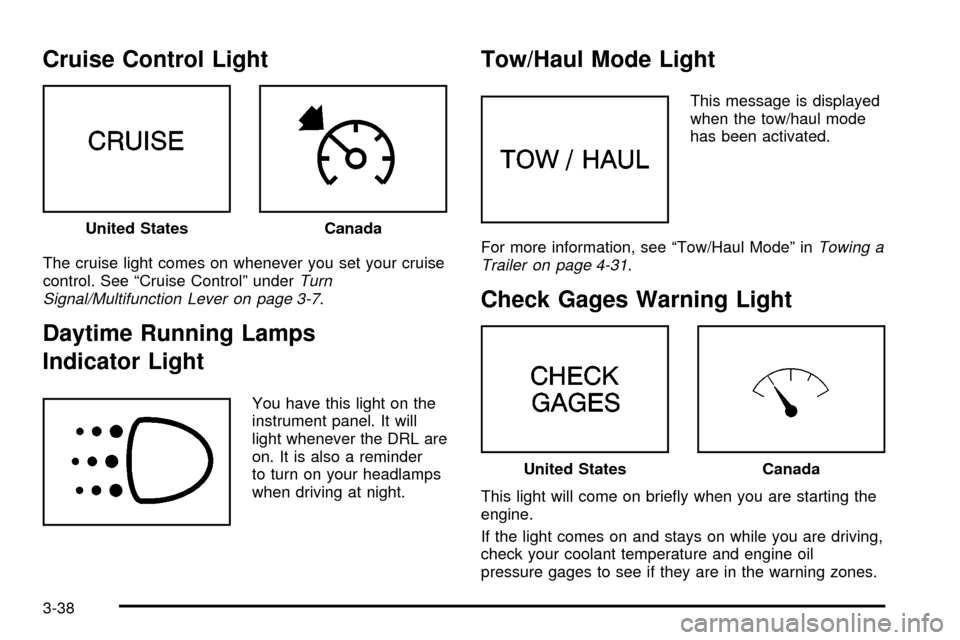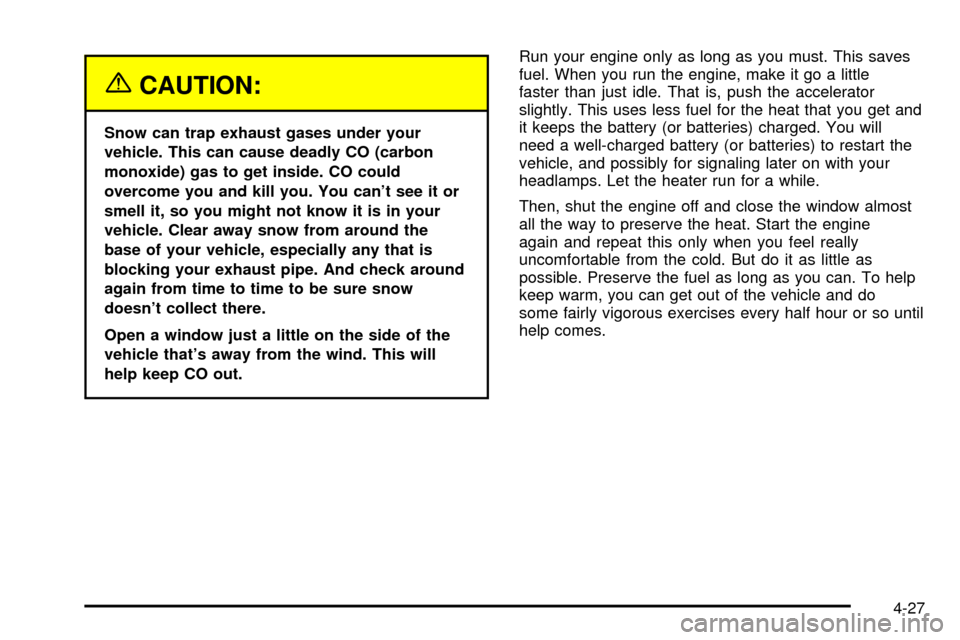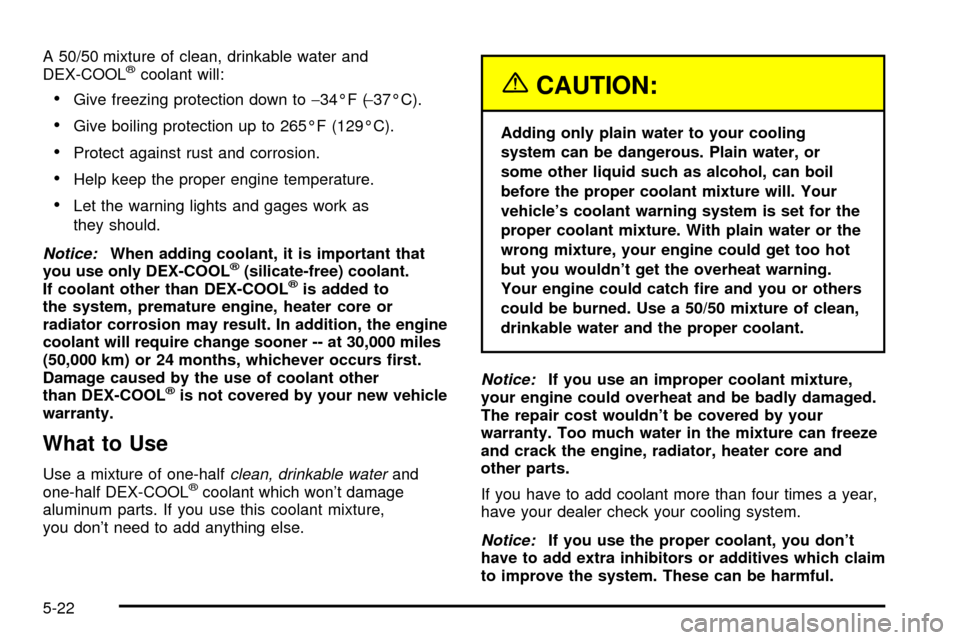2003 CHEVROLET EXPRESS CARGO VAN check engine light
[x] Cancel search: check engine lightPage 156 of 386

Cruise Control Light
The cruise light comes on whenever you set your cruise
control. See ªCruise Controlº underTurn
Signal/Multifunction Lever on page 3-7.
Daytime Running Lamps
Indicator Light
You have this light on the
instrument panel. It will
light whenever the DRL are
on. It is also a reminder
to turn on your headlamps
when driving at night.
Tow/Haul Mode Light
This message is displayed
when the tow/haul mode
has been activated.
For more information, see ªTow/Haul Modeº in
Towing a
Trailer on page 4-31.
Check Gages Warning Light
This light will come on brie¯y when you are starting the
engine.
If the light comes on and stays on while you are driving,
check your coolant temperature and engine oil
pressure gages to see if they are in the warning zones. United States
Canada
United StatesCanada
3-38
Page 200 of 386

Avoid needless heavy braking. Some people drive
in spurts Ð heavy acceleration followed by heavy
braking Ð rather than keeping pace with traffic. This is
a mistake. Your brakes may not have time to cool
between hard stops. Your brakes will wear out much
faster if you do a lot of heavy braking. If you keep pace
with the traffic and allow realistic following distances,
you will eliminate a lot of unnecessary braking.
That means better braking and longer brake life.
If your engine ever stops while you're driving, brake
normally but don't pump your brakes. If you do,
the pedal may get harder to push down. If your engine
stops, you will still have some power brake assist.
But you will use it when you brake. Once the power
assist is used up, it may take longer to stop and
the brake pedal will be harder to push.Anti-lock Brake System
Your vehicle has anti-lock brakes. ABS is an advanced
electronic braking system that will help prevent a
braking skid.
When you start your engine and begin to drive away,
your anti-lock brake system will check itself. You
may hear a momentary motor or clicking noise while
this test is going on. This is normal.
If there's a problem with
the anti-lock brake system,
this warning light will
stay on. See
Anti-Lock
Brake System Warning
Light on page 3-32
.
4-6
Page 214 of 386

Once you are moving on the freeway, make certain you
allow a reasonable following distance. Expect to
move slightly slower at night.
When you want to leave the freeway, move to the
proper lane well in advance. If you miss your exit, do
not, under any circumstances, stop and back up. Drive
on to the next exit.
The exit ramp can be curved, sometimes quite sharply.
The exit speed is usually posted.
Reduce your speed according to your speedometer, not
to your sense of motion. After driving for any distance
at higher speeds, you may tend to think you are
going slower than you actually are.
Before Leaving on a Long Trip
Make sure you're ready. Try to be well rested. If you
must start when you're not fresh Ð such as after a day's
work Ð don't plan to make too many miles that ®rst
part of the journey. Wear comfortable clothing and shoes
you can easily drive in.Is your vehicle ready for a long trip? If you keep it
serviced and maintained, it's ready to go. If it needs
service, have it done before starting out. Of course,
you'll ®nd experienced and able service experts in GM
dealerships all across North America. They'll be
ready and willing to help if you need it.
Here are some things you can check before a trip:
·Windshield Washer Fluid:Is the reservoir full? Are
all windows clean inside and outside?
·Wiper Blades:Are they in good shape?
·Fuel, Engine Oil, Other Fluids:Have you checked
all levels?
·Lamps:Are they all working? Are the lenses clean?
·Tires:They are vitally important to a safe,
trouble-free trip. Is the tread good enough for
long-distance driving? Are the tires all in¯ated to the
recommended pressure?
·Weather Forecasts:What's the weather outlook
along your route? Should you delay your trip a
short time to avoid a major storm system?
·Maps:Do you have up-to-date maps?
4-20
Page 221 of 386

{CAUTION:
Snow can trap exhaust gases under your
vehicle. This can cause deadly CO (carbon
monoxide) gas to get inside. CO could
overcome you and kill you. You can't see it or
smell it, so you might not know it is in your
vehicle. Clear away snow from around the
base of your vehicle, especially any that is
blocking your exhaust pipe. And check around
again from time to time to be sure snow
doesn't collect there.
Open a window just a little on the side of the
vehicle that's away from the wind. This will
help keep CO out.Run your engine only as long as you must. This saves
fuel. When you run the engine, make it go a little
faster than just idle. That is, push the accelerator
slightly. This uses less fuel for the heat that you get and
it keeps the battery (or batteries) charged. You will
need a well-charged battery (or batteries) to restart the
vehicle, and possibly for signaling later on with your
headlamps. Let the heater run for a while.
Then, shut the engine off and close the window almost
all the way to preserve the heat. Start the engine
again and repeat this only when you feel really
uncomfortable from the cold. But do it as little as
possible. Preserve the fuel as long as you can. To help
keep warm, you can get out of the vehicle and do
some fairly vigorous exercises every half hour or so until
help comes.
4-27
Page 292 of 386

A 50/50 mixture of clean, drinkable water and
DEX-COOLžcoolant will:
·Give freezing protection down to-34ÉF (-37ÉC).
·Give boiling protection up to 265ÉF (129ÉC).
·Protect against rust and corrosion.
·Help keep the proper engine temperature.
·Let the warning lights and gages work as
they should.
Notice:When adding coolant, it is important that
you use only DEX-COOLž(silicate-free) coolant.
If coolant other than DEX-COOLžis added to
the system, premature engine, heater core or
radiator corrosion may result. In addition, the engine
coolant will require change sooner -- at 30,000 miles
(50,000 km) or 24 months, whichever occurs ®rst.
Damage caused by the use of coolant other
than DEX-COOL
žis not covered by your new vehicle
warranty.
What to Use
Use a mixture of one-halfclean, drinkable waterand
one-half DEX-COOLžcoolant which won't damage
aluminum parts. If you use this coolant mixture,
you don't need to add anything else.
{CAUTION:
Adding only plain water to your cooling
system can be dangerous. Plain water, or
some other liquid such as alcohol, can boil
before the proper coolant mixture will. Your
vehicle's coolant warning system is set for the
proper coolant mixture. With plain water or the
wrong mixture, your engine could get too hot
but you wouldn't get the overheat warning.
Your engine could catch ®re and you or others
could be burned. Use a 50/50 mixture of clean,
drinkable water and the proper coolant.
Notice:If you use an improper coolant mixture,
your engine could overheat and be badly damaged.
The repair cost wouldn't be covered by your
warranty. Too much water in the mixture can freeze
and crack the engine, radiator, heater core and
other parts.
If you have to add coolant more than four times a year,
have your dealer check your cooling system.
Notice:If you use the proper coolant, you don't
have to add extra inhibitors or additives which claim
to improve the system. These can be harmful.
5-22
Page 373 of 386

Care of.........................................................5-83
Safety Belts................................................5-83
Your Cassette Tape Player............................3-74
Your CD Player...........................................3-75
Your CDs ...................................................3-75
Cargo Door Relocking....................................... 2-8
Cargo Vans and Cab and Chassis Models with
an Air Bag Off Switch..................................1-48
Cargo Vans and Cab and Chassis Models
without an Air Bag Off Switch........................1-47
Cargo Vans with a Passenger Air Bag and an
Air Bag Off Switch, Passenger Vans and Cab
and Chassis Models....................................1-37
Cargo Vans with a Passenger Air Bag and
without an Air Bag Off Switch........................1-40
Cassette Tape Messages.................................3-56
Cassette Tape Player Service...........................6-12
CD Adapter Kits.............................................3-56
Center High Mounted
Stoplamp (CHMSL)......................................5-54
Center High-Mounted Stoplamp.........................3-15
Center Passenger Position, Safety Belts.....1-25, 1-26
Chains, Tires..................................................5-63
Charging System Light....................................3-29
Check Engine Light.........................................3-33
Checking Brake Fluid......................................5-38
Checking Coolant............................................5-23
Checking Engine Oil........................................5-13
Checking Things Under the Hood....................... 5-9
Checking Your Restraint Systems......................1-74Check...........................................................3-33
Engine Light...............................................3-33
Gages Warning Light...................................3-38
Chemical Paint Spotting...................................5-87
Child Restraints..............................................1-42
Child Restraint Systems...............................1-42
Infants and Young Children...........................1-36
Lower Anchorages and Top Tethers for
Children (LATCH System)..........................1-51
Older Children.............................................1-34
Securing a Child Restraint Designed for the
LATCH System........................................1-53
Securing a Child Restraint in a Center
Seat Position...........................................1-56
Securing a Child Restraint in a Rear Outside
Seat Position...........................................1-53
Securing a Child Restraint in the Right Front
Seat Position...........................................1-58
Top Strap Anchor Location............................1-50
Top Strap...................................................1-48
Where to Put the Restraint...........................1-45
Chime Level Adjustment..................................3-75
Cigarette Lighter.............................................3-18
Cleaning Aluminum Wheels..............................5-85
Cleaning Exterior Lamps/Lenses.......................5-84
Cleaning Fabric/Carpet....................................5-80
Cleaning Glass Surfaces..................................5-82
Cleaning Interior Plastic Components.................5-82
Cleaning Leather............................................5-82
Cleaning the Top of the Instrument Panel...........5-82
3
Page 375 of 386

Driving Through Deep Standing Water...............4-17
Driving Through Flowing Water.........................4-17
Driving with a Trailer.......................................4-41
Driving..........................................................4-13
At Night.....................................................4-13
City...........................................................4-18
Defensive..................................................... 4-2
Drunken....................................................... 4-2
Freeway.....................................................4-19
Hill and Mountain Roads..............................4-22
In Rain and on Wet Roads...........................4-15
Winter........................................................4-24
Dual Stage Air Bags........................................1-67
Dual Tire Operation.........................................5-57
E
Electrical System............................................5-91
Add-On Equipment......................................5-91
Fuses and Circuit Breakers...........................5-92
Headlamp Wiring.........................................5-91
Windshield Wiper Fuses...............................5-91
Electronic Road-Speed Governor.......................3-26
Emissions Inspection and Maintenance
Programs...................................................3-35Engine Compartment Fuse Block......................5-94
Engine Coolant Level Check.............................6-11
Engine Oil Additives........................................5-15
Engine Oil and Chassis Lubrication Scheduled
Maintenance................................................. 6-5
Engine Oil Level Check...................................6-11
Engine..........................................................5-17
Air Cleaner/Filter.........................................5-17
Battery.......................................................5-40
Change Engine Oil Light...............................3-37
Check and Service Engine Soon Light............3-33
Compartment Overview................................5-12
Coolant Heater............................................2-23
Coolant Temperature Gage...........................3-32
Coolant......................................................5-21
Cooling System Inspection............................6-16
Exhaust.....................................................2-30
Fan Noise..................................................5-34
Oil .............................................................5-13
Overheating................................................5-24
Starting......................................................2-22
Entry Lighting.................................................3-17
Exit Lighting...................................................3-17
Extender, Safety Belt.......................................1-33
Exterior Lamps...............................................3-13
5
Page 376 of 386

F
Filter.............................................................5-17
Engine Air Cleaner......................................5-17
Finding a PTY Station.............................3-52, 3-63
Finding a Station....................3-42, 3-44, 3-49, 3-60
Finish Care....................................................5-84
Finish Damage...............................................5-86
Fixed Mast Antenna........................................3-75
Flash-To-Pass Feature....................................... 3-9
Flat Tire, Changing.........................................5-65
Flat Tire........................................................5-64
Floor Console Fuse Block................................5-92
Fluid.............................................................5-19
Automatic Transmission................................5-19
Power Steering...........................................5-34
Windshield Washer......................................5-35
FM ...............................................................3-73
Following Distance..........................................4-41
Footnotes........................................................ 6-5
Front Axle......................................................5-48
Fuel Regulator................................................2-22
Fuel............................................................... 5-4
Additives...................................................... 5-6
California Fuel.............................................. 5-5
Filling a Portable Fuel Container..................... 5-9Fuel (cont.)
Filling Your Tank........................................... 5-7
Fuels in Foreign Countries.............................. 5-6
Gage.........................................................3-39
Gasoline Octane........................................... 5-4
Gasoline Speci®cations.................................. 5-5
System Inspection.......................................6-16
Fuses...........................................................5-92
Fuses and Circuit Breakers...........................5-92
Windshield Wiper.........................................5-91
G
Gage............................................................3-38
Check Gages Warning Light..........................3-38
Engine Coolant Temperature.........................3-32
Fuel..........................................................3-39
Oil Pressure...............................................3-36
Speedometer..............................................3-25
Voltmeter Gage...........................................3-30
Gasoline......................................................... 5-4
Octane........................................................ 5-4
Speci®cations............................................... 5-5
GM Mobility Program for Persons with
Disabilities.................................................... 7-5
6